Business Strategy Analysis: Macro, Micro Environments & Samsung's Plan
VerifiedAdded on 2024/06/07
|24
|5467
|233
Report
AI Summary
This report provides a comprehensive analysis of Samsung's business strategies, focusing on the macro and micro environmental factors that influence the company's operations in the UK market. It employs frameworks such as PESTLE to assess the political, economic, sociological, technological, legal, and environmental factors impacting Samsung. The report also delves into the internal environment and capabilities of Samsung using value chain analysis, highlighting the importance of operations, marketing, sales, services, and human resource management. Furthermore, Porter's Five Forces model is applied to evaluate the competitive landscape, identifying key competitive pressures within the market sector. Finally, the report interprets and devises strategic planning recommendations for Samsung, considering the various environmental and competitive dynamics at play. Desklib is the perfect platform for students looking for similar solved assignments and past papers.
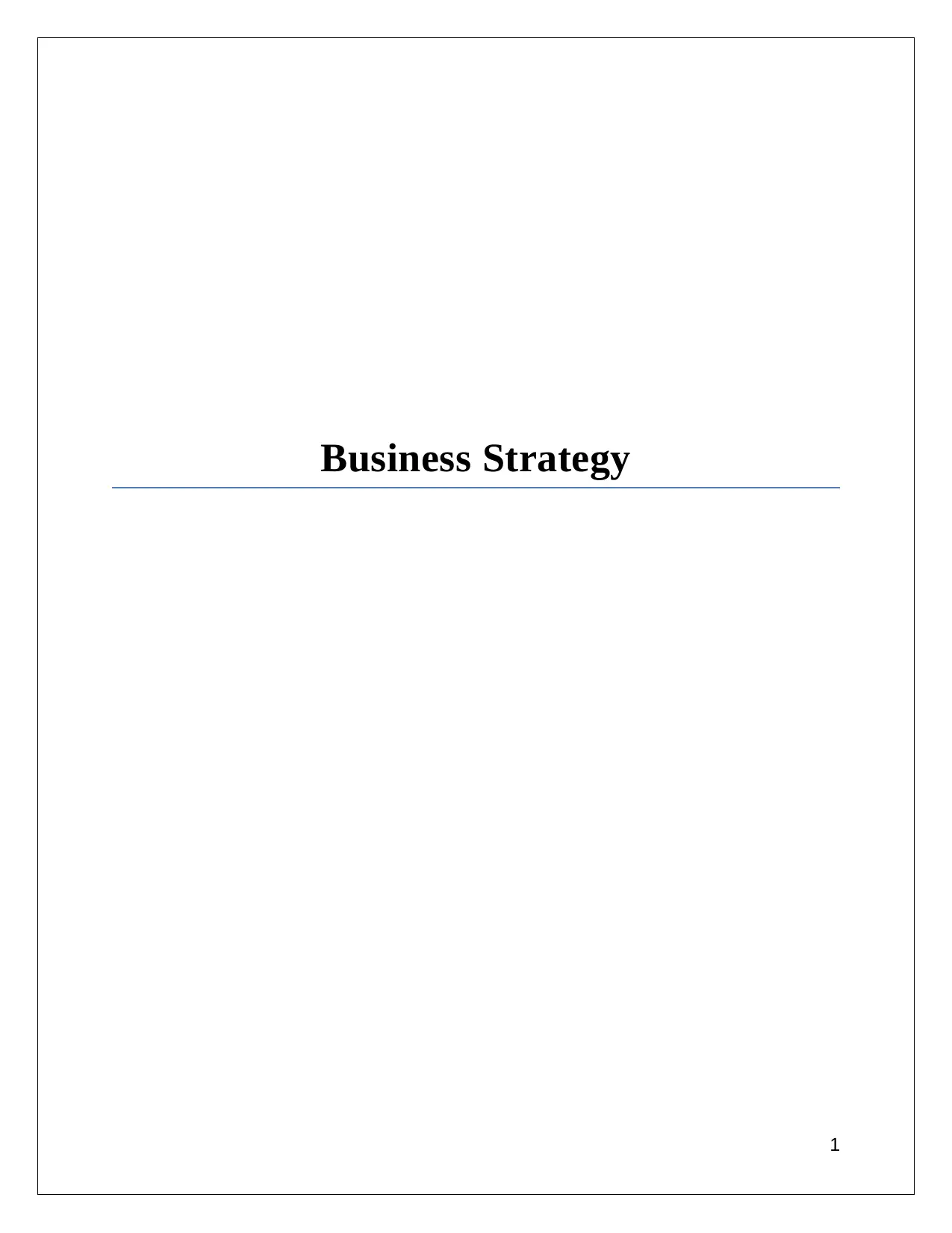
Business Strategy
1
1
Paraphrase This Document
Need a fresh take? Get an instant paraphrase of this document with our AI Paraphraser
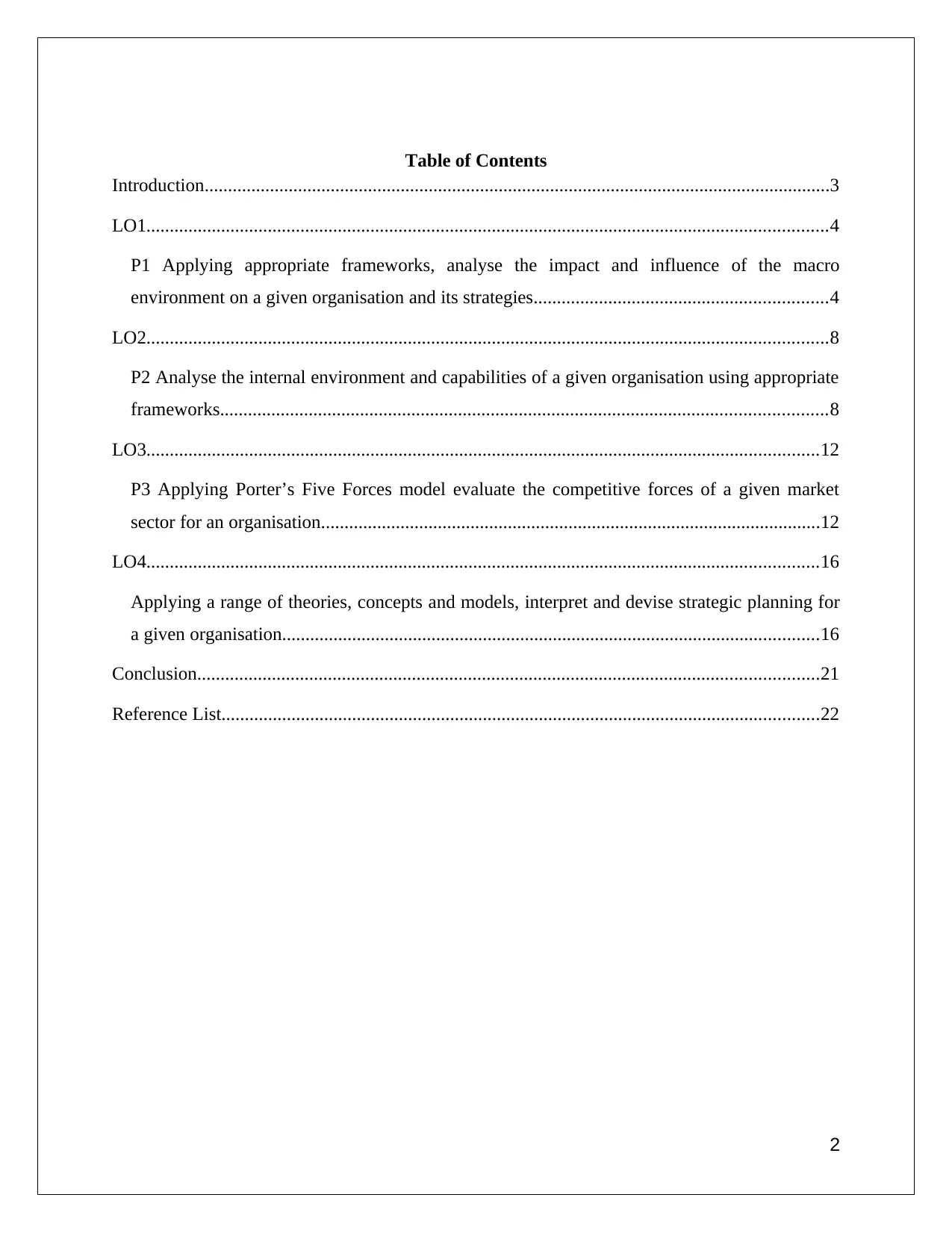
Table of Contents
Introduction......................................................................................................................................3
LO1..................................................................................................................................................4
P1 Applying appropriate frameworks, analyse the impact and influence of the macro
environment on a given organisation and its strategies...............................................................4
LO2..................................................................................................................................................8
P2 Analyse the internal environment and capabilities of a given organisation using appropriate
frameworks..................................................................................................................................8
LO3................................................................................................................................................12
P3 Applying Porter’s Five Forces model evaluate the competitive forces of a given market
sector for an organisation...........................................................................................................12
LO4................................................................................................................................................16
Applying a range of theories, concepts and models, interpret and devise strategic planning for
a given organisation...................................................................................................................16
Conclusion.....................................................................................................................................21
Reference List................................................................................................................................22
2
Introduction......................................................................................................................................3
LO1..................................................................................................................................................4
P1 Applying appropriate frameworks, analyse the impact and influence of the macro
environment on a given organisation and its strategies...............................................................4
LO2..................................................................................................................................................8
P2 Analyse the internal environment and capabilities of a given organisation using appropriate
frameworks..................................................................................................................................8
LO3................................................................................................................................................12
P3 Applying Porter’s Five Forces model evaluate the competitive forces of a given market
sector for an organisation...........................................................................................................12
LO4................................................................................................................................................16
Applying a range of theories, concepts and models, interpret and devise strategic planning for
a given organisation...................................................................................................................16
Conclusion.....................................................................................................................................21
Reference List................................................................................................................................22
2

Introduction
Business strategies are very important in effective running of an organization. All the business
strategies drawn out and implement after considering the macro and micro environmental
factors. In this assignment, Samsung has been taken into account for deriving various business
strategies, which would be beneficial to the company. Samsung is a well-known brand in the
market that produces a variety of electronic goods. Being a conglomerate, Samsung has huge
market shares in UK. However, with the rising number of competition in the market it needs to
changes its business strategies. A pestle analysis has been done in this project, which gives
insights about the strategies, which needs to be implemented. An analysis of the internal
environment has also been done in this project. Porter’s Five Force Model has been discussed
which sheds light on the growing competition in the market.
3
Business strategies are very important in effective running of an organization. All the business
strategies drawn out and implement after considering the macro and micro environmental
factors. In this assignment, Samsung has been taken into account for deriving various business
strategies, which would be beneficial to the company. Samsung is a well-known brand in the
market that produces a variety of electronic goods. Being a conglomerate, Samsung has huge
market shares in UK. However, with the rising number of competition in the market it needs to
changes its business strategies. A pestle analysis has been done in this project, which gives
insights about the strategies, which needs to be implemented. An analysis of the internal
environment has also been done in this project. Porter’s Five Force Model has been discussed
which sheds light on the growing competition in the market.
3
⊘ This is a preview!⊘
Do you want full access?
Subscribe today to unlock all pages.

Trusted by 1+ million students worldwide
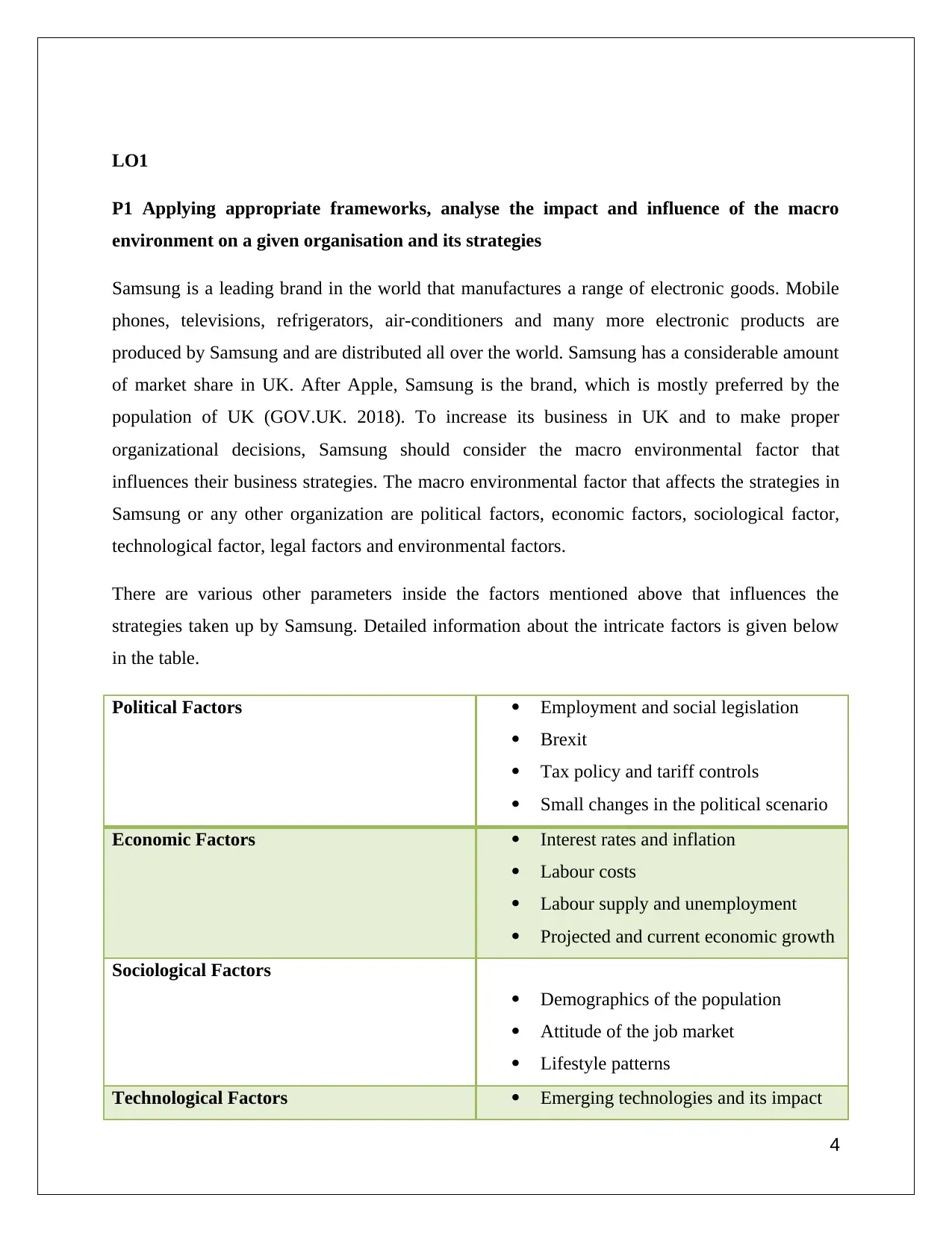
LO1
P1 Applying appropriate frameworks, analyse the impact and influence of the macro
environment on a given organisation and its strategies
Samsung is a leading brand in the world that manufactures a range of electronic goods. Mobile
phones, televisions, refrigerators, air-conditioners and many more electronic products are
produced by Samsung and are distributed all over the world. Samsung has a considerable amount
of market share in UK. After Apple, Samsung is the brand, which is mostly preferred by the
population of UK (GOV.UK. 2018). To increase its business in UK and to make proper
organizational decisions, Samsung should consider the macro environmental factor that
influences their business strategies. The macro environmental factor that affects the strategies in
Samsung or any other organization are political factors, economic factors, sociological factor,
technological factor, legal factors and environmental factors.
There are various other parameters inside the factors mentioned above that influences the
strategies taken up by Samsung. Detailed information about the intricate factors is given below
in the table.
Political Factors Employment and social legislation
Brexit
Tax policy and tariff controls
Small changes in the political scenario
Economic Factors Interest rates and inflation
Labour costs
Labour supply and unemployment
Projected and current economic growth
Sociological Factors
Demographics of the population
Attitude of the job market
Lifestyle patterns
Technological Factors Emerging technologies and its impact
4
P1 Applying appropriate frameworks, analyse the impact and influence of the macro
environment on a given organisation and its strategies
Samsung is a leading brand in the world that manufactures a range of electronic goods. Mobile
phones, televisions, refrigerators, air-conditioners and many more electronic products are
produced by Samsung and are distributed all over the world. Samsung has a considerable amount
of market share in UK. After Apple, Samsung is the brand, which is mostly preferred by the
population of UK (GOV.UK. 2018). To increase its business in UK and to make proper
organizational decisions, Samsung should consider the macro environmental factor that
influences their business strategies. The macro environmental factor that affects the strategies in
Samsung or any other organization are political factors, economic factors, sociological factor,
technological factor, legal factors and environmental factors.
There are various other parameters inside the factors mentioned above that influences the
strategies taken up by Samsung. Detailed information about the intricate factors is given below
in the table.
Political Factors Employment and social legislation
Brexit
Tax policy and tariff controls
Small changes in the political scenario
Economic Factors Interest rates and inflation
Labour costs
Labour supply and unemployment
Projected and current economic growth
Sociological Factors
Demographics of the population
Attitude of the job market
Lifestyle patterns
Technological Factors Emerging technologies and its impact
4
Paraphrase This Document
Need a fresh take? Get an instant paraphrase of this document with our AI Paraphraser
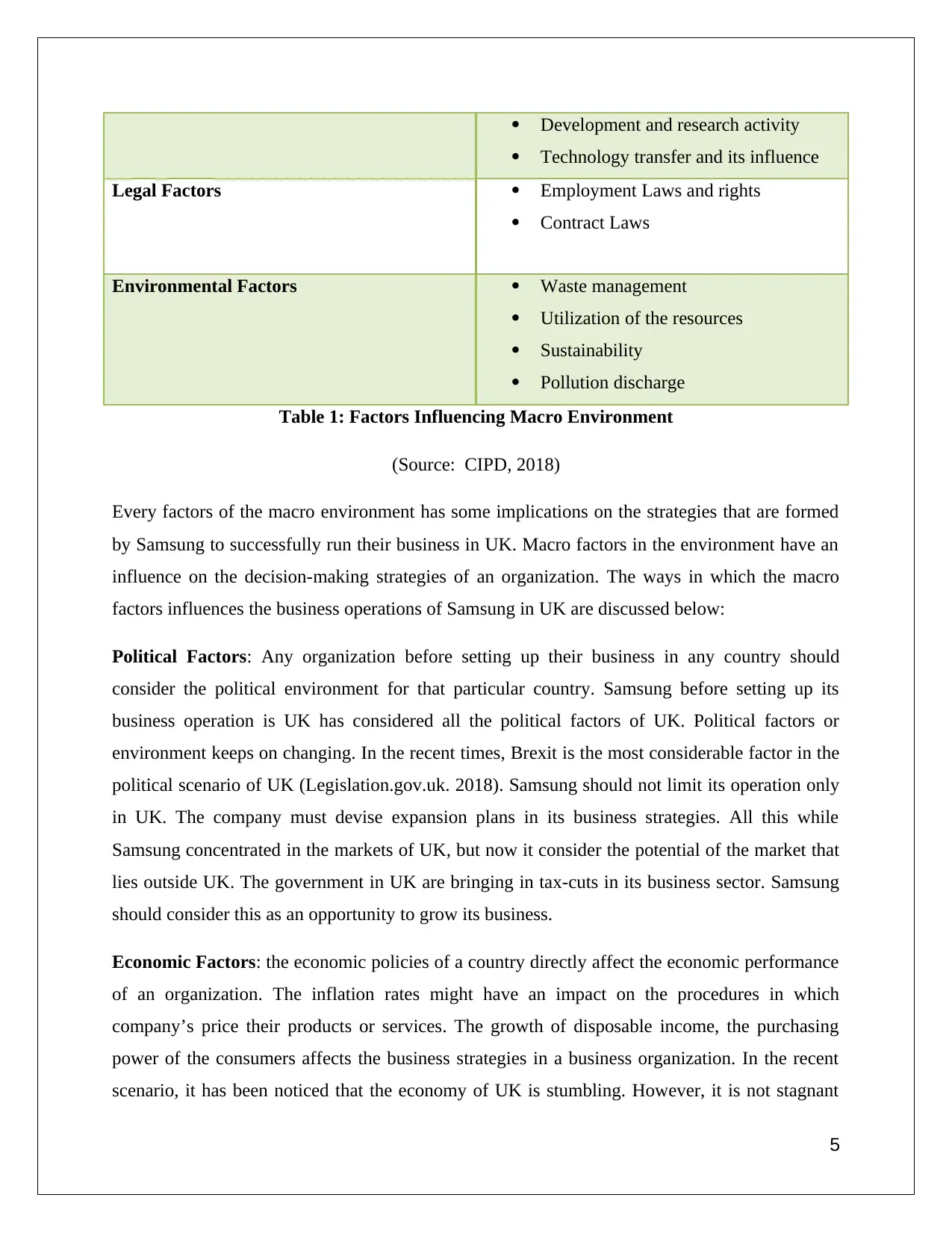
Development and research activity
Technology transfer and its influence
Legal Factors Employment Laws and rights
Contract Laws
Environmental Factors Waste management
Utilization of the resources
Sustainability
Pollution discharge
Table 1: Factors Influencing Macro Environment
(Source: CIPD, 2018)
Every factors of the macro environment has some implications on the strategies that are formed
by Samsung to successfully run their business in UK. Macro factors in the environment have an
influence on the decision-making strategies of an organization. The ways in which the macro
factors influences the business operations of Samsung in UK are discussed below:
Political Factors: Any organization before setting up their business in any country should
consider the political environment for that particular country. Samsung before setting up its
business operation is UK has considered all the political factors of UK. Political factors or
environment keeps on changing. In the recent times, Brexit is the most considerable factor in the
political scenario of UK (Legislation.gov.uk. 2018). Samsung should not limit its operation only
in UK. The company must devise expansion plans in its business strategies. All this while
Samsung concentrated in the markets of UK, but now it consider the potential of the market that
lies outside UK. The government in UK are bringing in tax-cuts in its business sector. Samsung
should consider this as an opportunity to grow its business.
Economic Factors: the economic policies of a country directly affect the economic performance
of an organization. The inflation rates might have an impact on the procedures in which
company’s price their products or services. The growth of disposable income, the purchasing
power of the consumers affects the business strategies in a business organization. In the recent
scenario, it has been noticed that the economy of UK is stumbling. However, it is not stagnant
5
Technology transfer and its influence
Legal Factors Employment Laws and rights
Contract Laws
Environmental Factors Waste management
Utilization of the resources
Sustainability
Pollution discharge
Table 1: Factors Influencing Macro Environment
(Source: CIPD, 2018)
Every factors of the macro environment has some implications on the strategies that are formed
by Samsung to successfully run their business in UK. Macro factors in the environment have an
influence on the decision-making strategies of an organization. The ways in which the macro
factors influences the business operations of Samsung in UK are discussed below:
Political Factors: Any organization before setting up their business in any country should
consider the political environment for that particular country. Samsung before setting up its
business operation is UK has considered all the political factors of UK. Political factors or
environment keeps on changing. In the recent times, Brexit is the most considerable factor in the
political scenario of UK (Legislation.gov.uk. 2018). Samsung should not limit its operation only
in UK. The company must devise expansion plans in its business strategies. All this while
Samsung concentrated in the markets of UK, but now it consider the potential of the market that
lies outside UK. The government in UK are bringing in tax-cuts in its business sector. Samsung
should consider this as an opportunity to grow its business.
Economic Factors: the economic policies of a country directly affect the economic performance
of an organization. The inflation rates might have an impact on the procedures in which
company’s price their products or services. The growth of disposable income, the purchasing
power of the consumers affects the business strategies in a business organization. In the recent
scenario, it has been noticed that the economy of UK is stumbling. However, it is not stagnant
5

(PwC, 2018). There have been false prophecies that the economy of the country will collapse.
Samsung should study the economic factors that prevail in UK very carefully. As per the
economic scenario, Samsung should not invest huge capital its operations and manufacturing in
UK particularly.
Sociological Factors: The demographics of a country have a direct impact on the business
strategies taken up by an organization. In UK, the demographics say that, the population of UK
is growing old. However, this is not the scenario in every part of UK. Some parts have
population, which is youth centric. Samsung should concentrate on manufacturing a range of
products, which are user-friendly to the people who belong to the age group of 40 and above
(Hayter, 2018). Due to increasing amount of disposable income among the population of UK, the
lifestyle patterns have witnessed change. People indulge themselves in buying high-end
products. This has provided Samsung with a potential market, which will serve the youth. The
attitude of job market has changed in UK. Samsung should tap the potential market, which has a
lot of talent. This talent can be beneficial to Samsung. The organization should include effective
recruitment in its business strategies.
Technological Factor: UK is a technologically advanced nation. Everyday there are various
inventions that are taking place all over UK. Samsung should devise strategies in its business
operation so that it can use the upcoming technological advancements. It can conduct surveys
through digital mediums and learn about the preferences of the consumers. This would help the
organization to come up with products, which are according to the taste of the consumers.
Legal Factors: There are many laws like contract laws, employment laws, the rights of the
employees, copyright laws, health and safety law that are in use in UK. All the organizations
operating in UK should devise its business strategies that are aligned to the government laws
(Legislation.gov.uk. 2018). Samsung follows all the laws that are written down in the legislation
of UK for the business sector. When organizations do not follow, the rules are they eligible to get
fined by the government. All the rules and regulations followed in Samsung are employee
friendly. They do not indulge themselves in illegal activities. The employees are given salaries
and leaves according to employment legislation followed in UK.
6
Samsung should study the economic factors that prevail in UK very carefully. As per the
economic scenario, Samsung should not invest huge capital its operations and manufacturing in
UK particularly.
Sociological Factors: The demographics of a country have a direct impact on the business
strategies taken up by an organization. In UK, the demographics say that, the population of UK
is growing old. However, this is not the scenario in every part of UK. Some parts have
population, which is youth centric. Samsung should concentrate on manufacturing a range of
products, which are user-friendly to the people who belong to the age group of 40 and above
(Hayter, 2018). Due to increasing amount of disposable income among the population of UK, the
lifestyle patterns have witnessed change. People indulge themselves in buying high-end
products. This has provided Samsung with a potential market, which will serve the youth. The
attitude of job market has changed in UK. Samsung should tap the potential market, which has a
lot of talent. This talent can be beneficial to Samsung. The organization should include effective
recruitment in its business strategies.
Technological Factor: UK is a technologically advanced nation. Everyday there are various
inventions that are taking place all over UK. Samsung should devise strategies in its business
operation so that it can use the upcoming technological advancements. It can conduct surveys
through digital mediums and learn about the preferences of the consumers. This would help the
organization to come up with products, which are according to the taste of the consumers.
Legal Factors: There are many laws like contract laws, employment laws, the rights of the
employees, copyright laws, health and safety law that are in use in UK. All the organizations
operating in UK should devise its business strategies that are aligned to the government laws
(Legislation.gov.uk. 2018). Samsung follows all the laws that are written down in the legislation
of UK for the business sector. When organizations do not follow, the rules are they eligible to get
fined by the government. All the rules and regulations followed in Samsung are employee
friendly. They do not indulge themselves in illegal activities. The employees are given salaries
and leaves according to employment legislation followed in UK.
6
⊘ This is a preview!⊘
Do you want full access?
Subscribe today to unlock all pages.

Trusted by 1+ million students worldwide
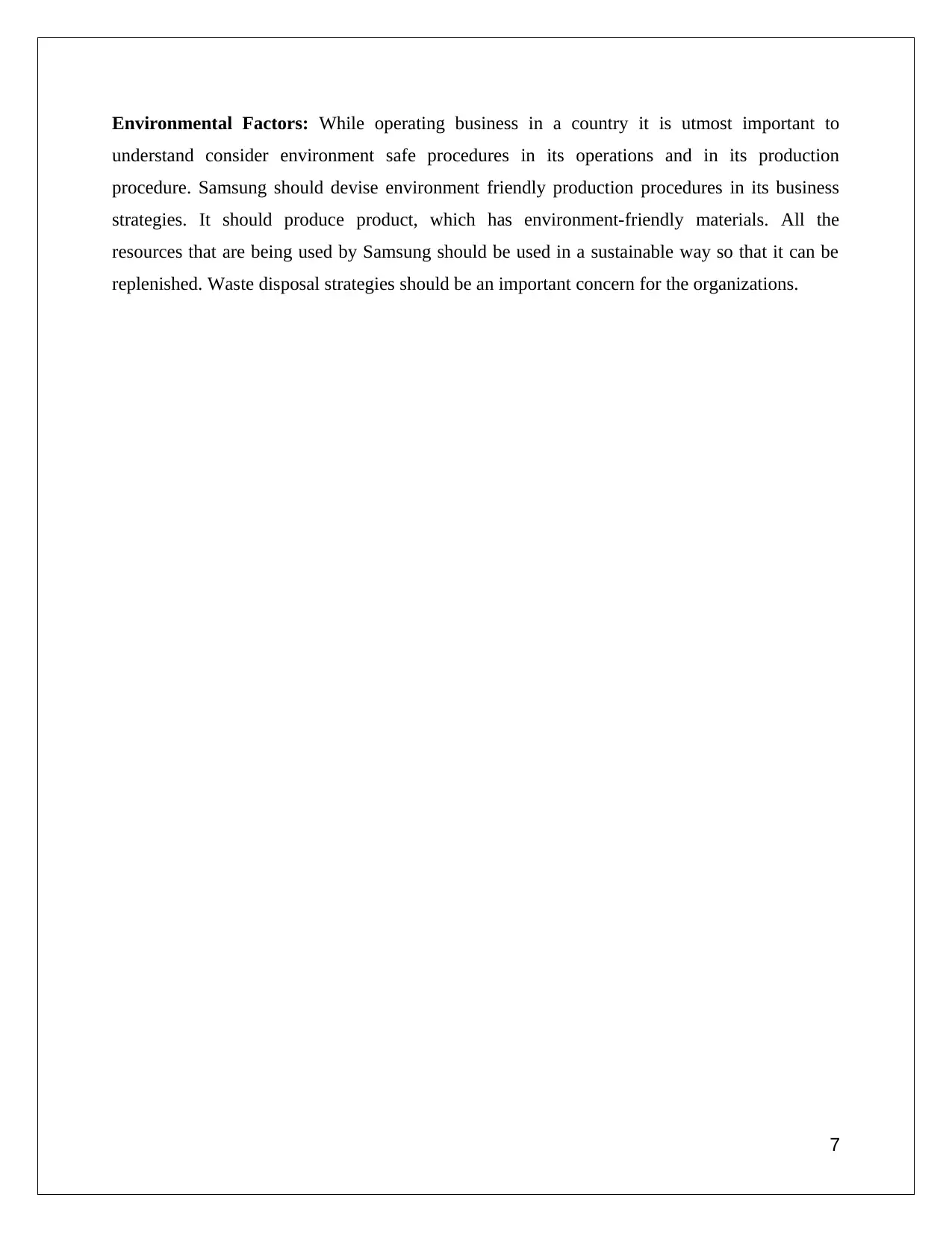
Environmental Factors: While operating business in a country it is utmost important to
understand consider environment safe procedures in its operations and in its production
procedure. Samsung should devise environment friendly production procedures in its business
strategies. It should produce product, which has environment-friendly materials. All the
resources that are being used by Samsung should be used in a sustainable way so that it can be
replenished. Waste disposal strategies should be an important concern for the organizations.
7
understand consider environment safe procedures in its operations and in its production
procedure. Samsung should devise environment friendly production procedures in its business
strategies. It should produce product, which has environment-friendly materials. All the
resources that are being used by Samsung should be used in a sustainable way so that it can be
replenished. Waste disposal strategies should be an important concern for the organizations.
7
Paraphrase This Document
Need a fresh take? Get an instant paraphrase of this document with our AI Paraphraser
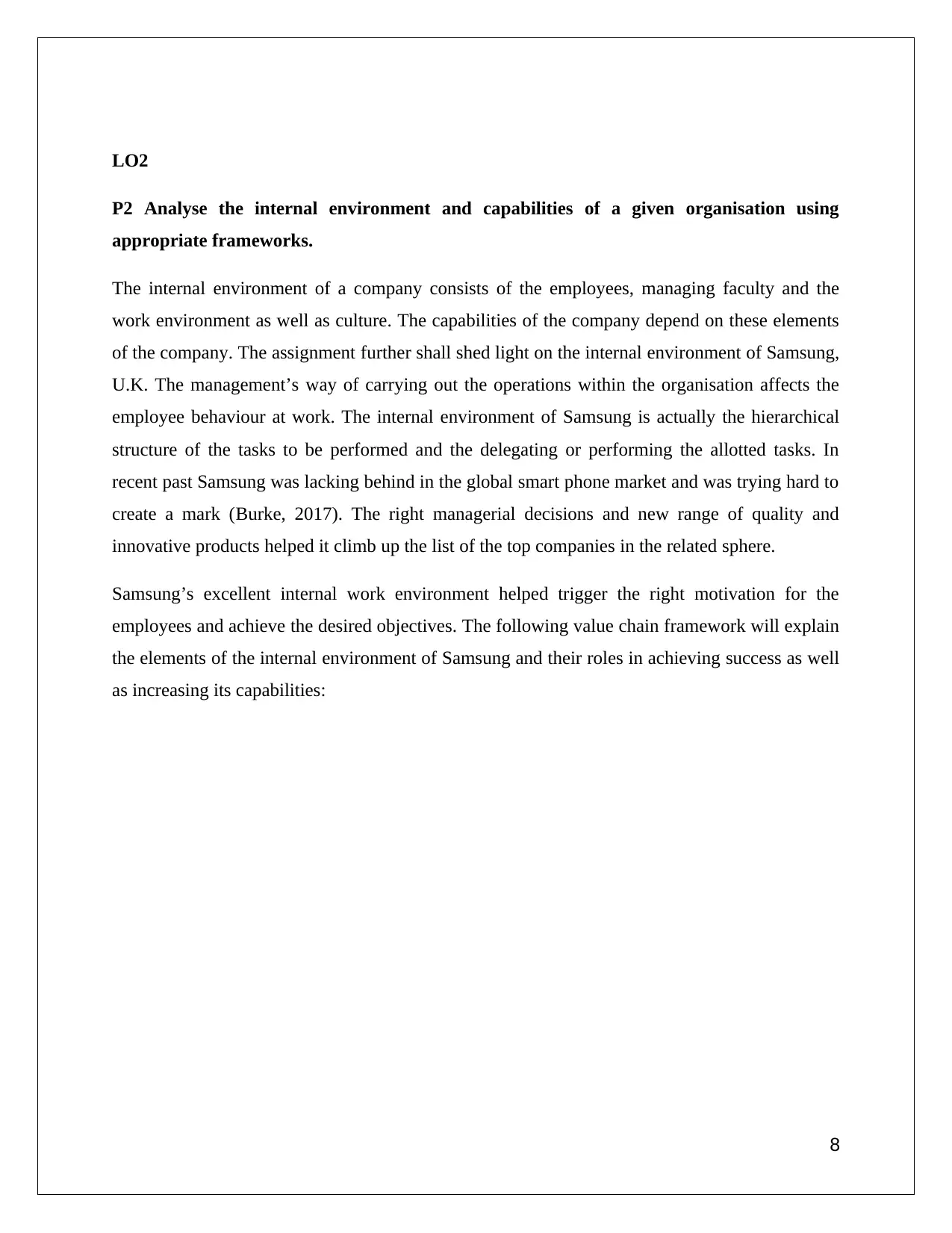
LO2
P2 Analyse the internal environment and capabilities of a given organisation using
appropriate frameworks.
The internal environment of a company consists of the employees, managing faculty and the
work environment as well as culture. The capabilities of the company depend on these elements
of the company. The assignment further shall shed light on the internal environment of Samsung,
U.K. The management’s way of carrying out the operations within the organisation affects the
employee behaviour at work. The internal environment of Samsung is actually the hierarchical
structure of the tasks to be performed and the delegating or performing the allotted tasks. In
recent past Samsung was lacking behind in the global smart phone market and was trying hard to
create a mark (Burke, 2017). The right managerial decisions and new range of quality and
innovative products helped it climb up the list of the top companies in the related sphere.
Samsung’s excellent internal work environment helped trigger the right motivation for the
employees and achieve the desired objectives. The following value chain framework will explain
the elements of the internal environment of Samsung and their roles in achieving success as well
as increasing its capabilities:
8
P2 Analyse the internal environment and capabilities of a given organisation using
appropriate frameworks.
The internal environment of a company consists of the employees, managing faculty and the
work environment as well as culture. The capabilities of the company depend on these elements
of the company. The assignment further shall shed light on the internal environment of Samsung,
U.K. The management’s way of carrying out the operations within the organisation affects the
employee behaviour at work. The internal environment of Samsung is actually the hierarchical
structure of the tasks to be performed and the delegating or performing the allotted tasks. In
recent past Samsung was lacking behind in the global smart phone market and was trying hard to
create a mark (Burke, 2017). The right managerial decisions and new range of quality and
innovative products helped it climb up the list of the top companies in the related sphere.
Samsung’s excellent internal work environment helped trigger the right motivation for the
employees and achieve the desired objectives. The following value chain framework will explain
the elements of the internal environment of Samsung and their roles in achieving success as well
as increasing its capabilities:
8
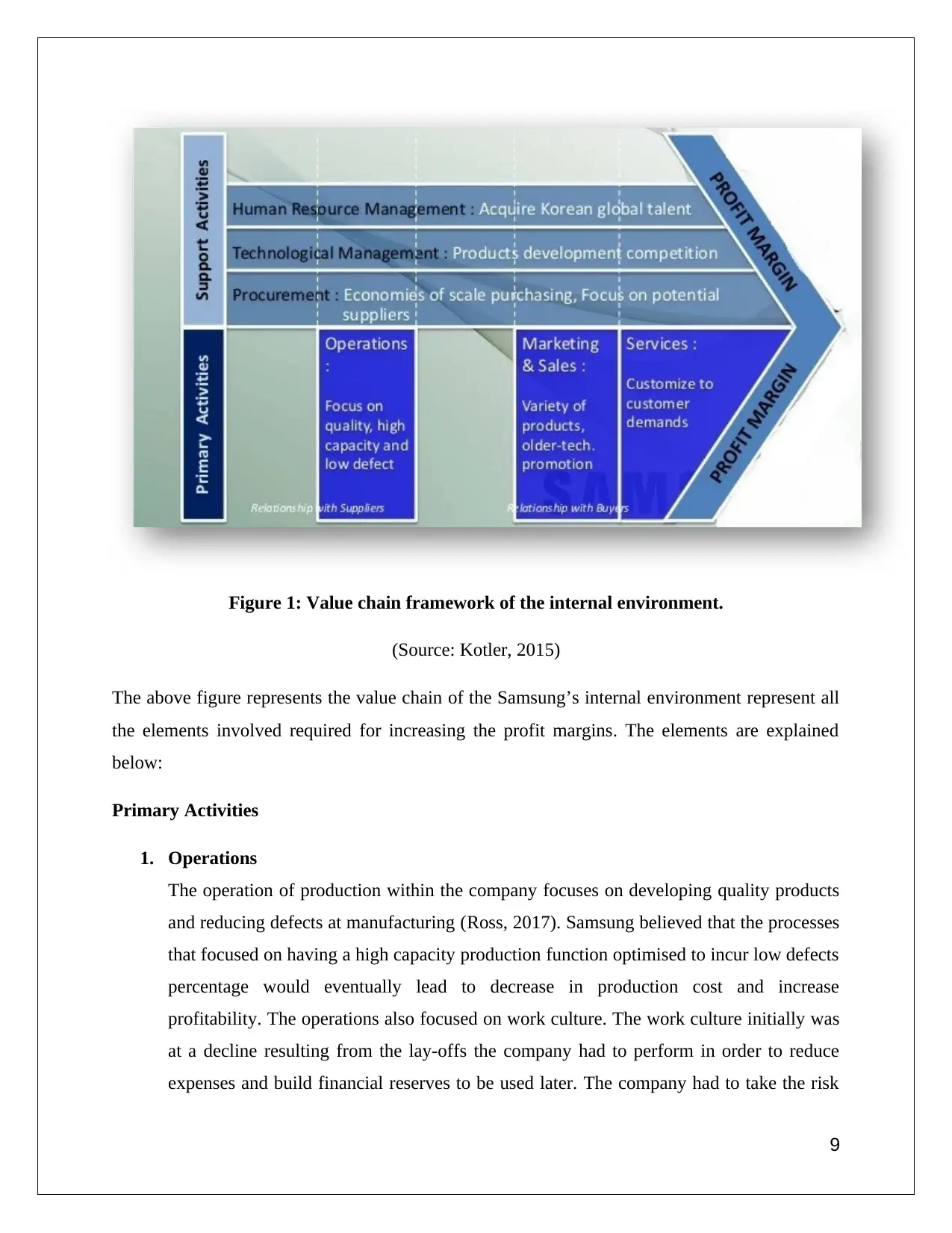
Figure 1: Value chain framework of the internal environment.
(Source: Kotler, 2015)
The above figure represents the value chain of the Samsung’s internal environment represent all
the elements involved required for increasing the profit margins. The elements are explained
below:
Primary Activities
1. Operations
The operation of production within the company focuses on developing quality products
and reducing defects at manufacturing (Ross, 2017). Samsung believed that the processes
that focused on having a high capacity production function optimised to incur low defects
percentage would eventually lead to decrease in production cost and increase
profitability. The operations also focused on work culture. The work culture initially was
at a decline resulting from the lay-offs the company had to perform in order to reduce
expenses and build financial reserves to be used later. The company had to take the risk
9
(Source: Kotler, 2015)
The above figure represents the value chain of the Samsung’s internal environment represent all
the elements involved required for increasing the profit margins. The elements are explained
below:
Primary Activities
1. Operations
The operation of production within the company focuses on developing quality products
and reducing defects at manufacturing (Ross, 2017). Samsung believed that the processes
that focused on having a high capacity production function optimised to incur low defects
percentage would eventually lead to decrease in production cost and increase
profitability. The operations also focused on work culture. The work culture initially was
at a decline resulting from the lay-offs the company had to perform in order to reduce
expenses and build financial reserves to be used later. The company had to take the risk
9
⊘ This is a preview!⊘
Do you want full access?
Subscribe today to unlock all pages.

Trusted by 1+ million students worldwide

of causing employee de-motivation and demoralisation. The building of financial
reserves however helped provide the remaining employees a better package and a
renewed scope of growth and learning.
2. Marketing and Sales
The company changed its outlook towards the marketing functions. The four Ps of
marketing helped it identify and areas it required changes in order to grow. The product
function was strengthened by introducing a large range of quality products and a good
after sale service to retain customer loyalty. The multiple product range helped it to
increase the revenue and help the company allotted financial funds towards research and
development of more quality and high-end products. The price factor was also taken care
of by providing penetrating and introductory prices in the market to help increase demand
and make the customers used to good quality products at a low price. This helped in
warding off competition (Kotler, 2015). The place function of marketing mix was utilised
well by Samsung and it initiated a process of launching new product sites and showrooms
across the U.K. The promotion function was too tackled well and helped in pushing sales
through mass advertising. Providing sponsorships aided promotion and made Samsung a
household name.
3. Services
Innovation and re-invention is one of the key elements that bought Samsung back on the
list of top performers and paved its way to become a market leader. The idea of shifting
to the android platform was one the best decisions taken by the company to provide a
service to the customers which catered to their changing needs. Samsung’s current
platform association with Android helps the users of its products keep themselves
updated with latest available versions of the operating system and help them continue
using the product. The customer service was increased significantly with the introduction
of a large group of products consisting of cheaper substitutes as well as flagship products.
This further helps the company to retain consumers by meeting their current needs and
increase consumer loyalty.
Support Activities
1. Human Resource Management
10
reserves however helped provide the remaining employees a better package and a
renewed scope of growth and learning.
2. Marketing and Sales
The company changed its outlook towards the marketing functions. The four Ps of
marketing helped it identify and areas it required changes in order to grow. The product
function was strengthened by introducing a large range of quality products and a good
after sale service to retain customer loyalty. The multiple product range helped it to
increase the revenue and help the company allotted financial funds towards research and
development of more quality and high-end products. The price factor was also taken care
of by providing penetrating and introductory prices in the market to help increase demand
and make the customers used to good quality products at a low price. This helped in
warding off competition (Kotler, 2015). The place function of marketing mix was utilised
well by Samsung and it initiated a process of launching new product sites and showrooms
across the U.K. The promotion function was too tackled well and helped in pushing sales
through mass advertising. Providing sponsorships aided promotion and made Samsung a
household name.
3. Services
Innovation and re-invention is one of the key elements that bought Samsung back on the
list of top performers and paved its way to become a market leader. The idea of shifting
to the android platform was one the best decisions taken by the company to provide a
service to the customers which catered to their changing needs. Samsung’s current
platform association with Android helps the users of its products keep themselves
updated with latest available versions of the operating system and help them continue
using the product. The customer service was increased significantly with the introduction
of a large group of products consisting of cheaper substitutes as well as flagship products.
This further helps the company to retain consumers by meeting their current needs and
increase consumer loyalty.
Support Activities
1. Human Resource Management
10
Paraphrase This Document
Need a fresh take? Get an instant paraphrase of this document with our AI Paraphraser
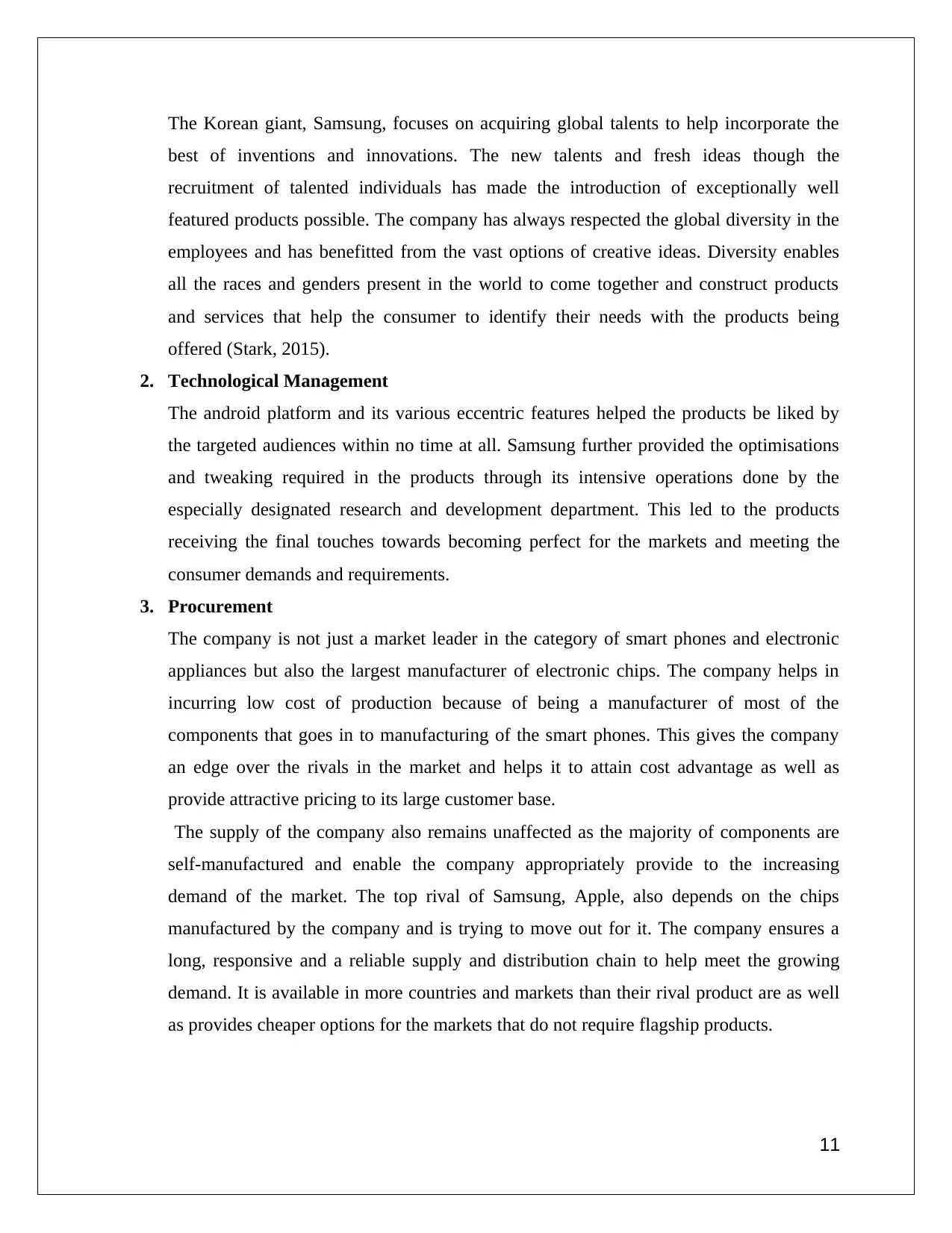
The Korean giant, Samsung, focuses on acquiring global talents to help incorporate the
best of inventions and innovations. The new talents and fresh ideas though the
recruitment of talented individuals has made the introduction of exceptionally well
featured products possible. The company has always respected the global diversity in the
employees and has benefitted from the vast options of creative ideas. Diversity enables
all the races and genders present in the world to come together and construct products
and services that help the consumer to identify their needs with the products being
offered (Stark, 2015).
2. Technological Management
The android platform and its various eccentric features helped the products be liked by
the targeted audiences within no time at all. Samsung further provided the optimisations
and tweaking required in the products through its intensive operations done by the
especially designated research and development department. This led to the products
receiving the final touches towards becoming perfect for the markets and meeting the
consumer demands and requirements.
3. Procurement
The company is not just a market leader in the category of smart phones and electronic
appliances but also the largest manufacturer of electronic chips. The company helps in
incurring low cost of production because of being a manufacturer of most of the
components that goes in to manufacturing of the smart phones. This gives the company
an edge over the rivals in the market and helps it to attain cost advantage as well as
provide attractive pricing to its large customer base.
The supply of the company also remains unaffected as the majority of components are
self-manufactured and enable the company appropriately provide to the increasing
demand of the market. The top rival of Samsung, Apple, also depends on the chips
manufactured by the company and is trying to move out for it. The company ensures a
long, responsive and a reliable supply and distribution chain to help meet the growing
demand. It is available in more countries and markets than their rival product are as well
as provides cheaper options for the markets that do not require flagship products.
11
best of inventions and innovations. The new talents and fresh ideas though the
recruitment of talented individuals has made the introduction of exceptionally well
featured products possible. The company has always respected the global diversity in the
employees and has benefitted from the vast options of creative ideas. Diversity enables
all the races and genders present in the world to come together and construct products
and services that help the consumer to identify their needs with the products being
offered (Stark, 2015).
2. Technological Management
The android platform and its various eccentric features helped the products be liked by
the targeted audiences within no time at all. Samsung further provided the optimisations
and tweaking required in the products through its intensive operations done by the
especially designated research and development department. This led to the products
receiving the final touches towards becoming perfect for the markets and meeting the
consumer demands and requirements.
3. Procurement
The company is not just a market leader in the category of smart phones and electronic
appliances but also the largest manufacturer of electronic chips. The company helps in
incurring low cost of production because of being a manufacturer of most of the
components that goes in to manufacturing of the smart phones. This gives the company
an edge over the rivals in the market and helps it to attain cost advantage as well as
provide attractive pricing to its large customer base.
The supply of the company also remains unaffected as the majority of components are
self-manufactured and enable the company appropriately provide to the increasing
demand of the market. The top rival of Samsung, Apple, also depends on the chips
manufactured by the company and is trying to move out for it. The company ensures a
long, responsive and a reliable supply and distribution chain to help meet the growing
demand. It is available in more countries and markets than their rival product are as well
as provides cheaper options for the markets that do not require flagship products.
11
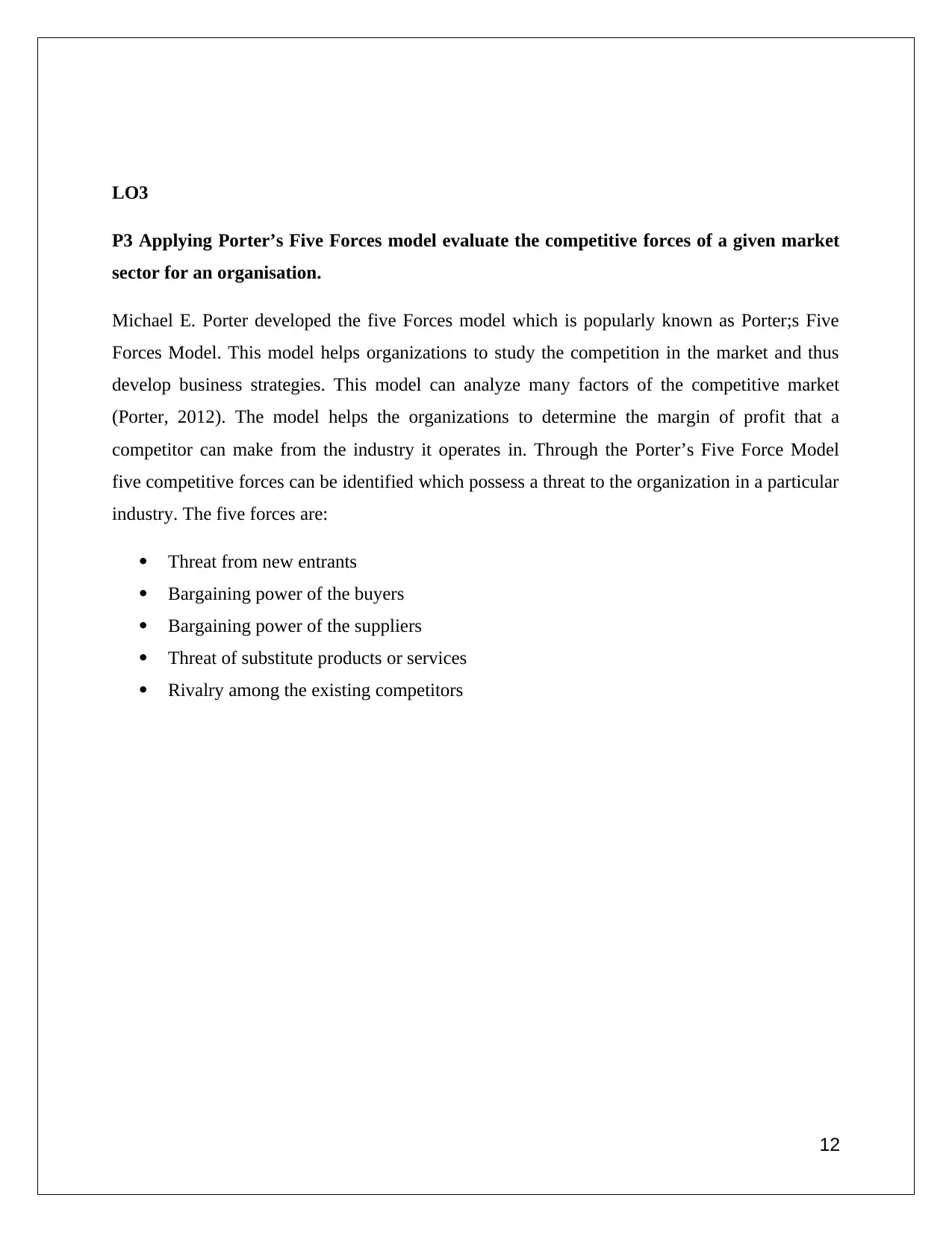
LO3
P3 Applying Porter’s Five Forces model evaluate the competitive forces of a given market
sector for an organisation.
Michael E. Porter developed the five Forces model which is popularly known as Porter;s Five
Forces Model. This model helps organizations to study the competition in the market and thus
develop business strategies. This model can analyze many factors of the competitive market
(Porter, 2012). The model helps the organizations to determine the margin of profit that a
competitor can make from the industry it operates in. Through the Porter’s Five Force Model
five competitive forces can be identified which possess a threat to the organization in a particular
industry. The five forces are:
Threat from new entrants
Bargaining power of the buyers
Bargaining power of the suppliers
Threat of substitute products or services
Rivalry among the existing competitors
12
P3 Applying Porter’s Five Forces model evaluate the competitive forces of a given market
sector for an organisation.
Michael E. Porter developed the five Forces model which is popularly known as Porter;s Five
Forces Model. This model helps organizations to study the competition in the market and thus
develop business strategies. This model can analyze many factors of the competitive market
(Porter, 2012). The model helps the organizations to determine the margin of profit that a
competitor can make from the industry it operates in. Through the Porter’s Five Force Model
five competitive forces can be identified which possess a threat to the organization in a particular
industry. The five forces are:
Threat from new entrants
Bargaining power of the buyers
Bargaining power of the suppliers
Threat of substitute products or services
Rivalry among the existing competitors
12
⊘ This is a preview!⊘
Do you want full access?
Subscribe today to unlock all pages.

Trusted by 1+ million students worldwide
1 out of 24
Related Documents
Your All-in-One AI-Powered Toolkit for Academic Success.
+13062052269
info@desklib.com
Available 24*7 on WhatsApp / Email
![[object Object]](/_next/static/media/star-bottom.7253800d.svg)
Unlock your academic potential
Copyright © 2020–2025 A2Z Services. All Rights Reserved. Developed and managed by ZUCOL.





